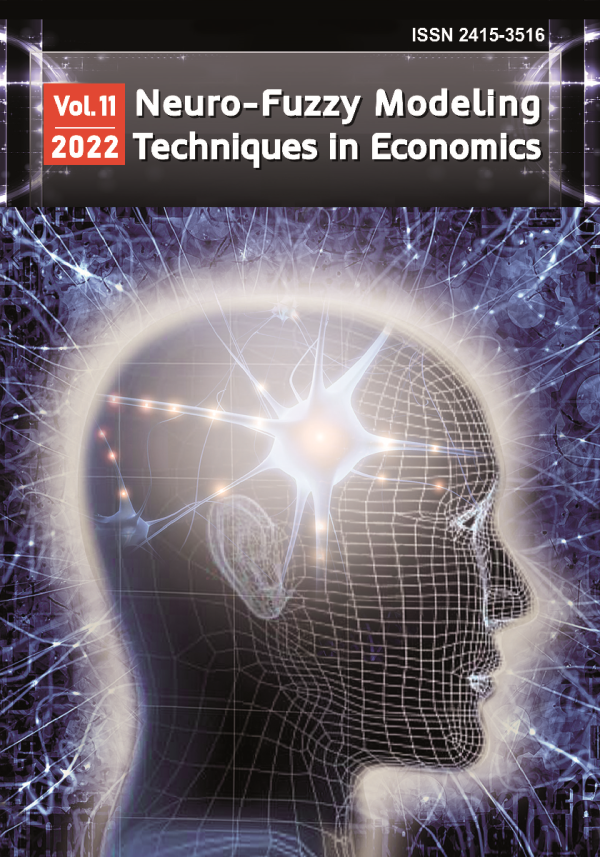
Neuro-Fuzzy Modeling Techniques in Economics
ISSN 2415-3516
Моделі поділу ринку на торгові зони в нечітких умовах
Models of market division into trade areas in the fuzzy conditions
DOI:
10.33111/nfmte.2015.189
Анотація: Конкурентна боротьба за ринок збуту привела до виникнення проблеми поділу ринку на торгові зони та появи численних моделей торгових зон. Класичні моделі, які одержали назву «моделі просторової взаємодії», описують поділ на торгові зони в чітких умовах. Для побудови моделей, більш адекватних умовам сучасної економіки, доцільно використовувати теорію нечітких множин.
У статті запропоновано новий підхід до поділу ринку на торгові зони в нечітких умовах на підґрунті застосування відстані Хеммінга, який враховує економічний зміст задачі та усуває некоректності класичного підходу, основаного на композиції бінарних відношень. Введено нові поняття, такі як відстань Хеммінга з додатнім відхиленням для нечіткої множини та відстань Хеммінга з від’ємним відхиленням для нечіткої множини. Запропоновано методологію визначення порогу поділу, а також розширення поняття розв’язку задачі поділу на торгові зони. Запропоновано не тільки виділяти торгові зони, а й досліджувати первинні, вторинні, третинні торгові зони як ступінь належності до потенційного споживача, використовуючи значення функцій належності.
Результати розв’язання прикладної задачі за допомогою запропонованого нами підходу є логічними і не суперечливими реальним процесам в економіці.
Abstract: Competition for market led to the problem of market division into trade areas and the appearance of numerous models of trade areas.
Classical models, which are called as "models of spatial interaction", describe the market division into trade areas in precise conditions. To build more adequate models to modern economy it’s appropriate to use the theory of fuzzy sets.
It is proposed in the article a new approach to market division into trade areas in fuzzy conditions with usage of Hamming distance, which takes into account the economic sense of the problem and eliminates the incorrectness of classical approach, based on the composition of binary relations. It’s introduced the new concepts such as the Hamming distance with positive deviation for fuzzy set and the Hamming distance with negative deviation for fuzzy set. There is developed in the article the methodology of determining the threshold of separation and proposed the expansion of the concept of solving the problem of market division into trade areas. So, it’s proposed not only to allocate the trade areas, but also research primary, secondary and tertiary trade zones as the degree of belonging to a potential customer using the values of the membership functions. The results of solving of applied problem under our approach is logical and not contradictory to real processes in the economy
Ключові слова: Модель поділу, торгові зони, композиція бінарних відношень, відстань Хеммінга для нечіткої множини, відстань Хеммінга з додатнім відхиленням для нечіткої множини, нечіткий кластер, поріг поділу
Key words: Model of division, trade areas, the composition of binary relations, the Hamming distance for fuzzy set, the Hamming distance with positive deviation for fuzzy set, fuzzy cluster, the threshold of division.
УДК: 519.86
UDC: 519.86
JEL: C69 D11 F17
To cite paper
In APA style
Tarasova, L., & Piskunova, O. (2015). Models of market division into trade areas in the fuzzy conditions. Neuro-Fuzzy Modeling Techniques in Economics, 4, 189-217. http://doi.org/10.33111/nfmte.2015.189
In MON style
Тарасова Л., Піскунова О.В. Моделі поділу ринку на торгові зони в нечітких умовах. Нейро-нечіткі технології моделювання в економіці. 2015. № 4. С. 189-217. http://doi.org/10.33111/nfmte.2015.189 (дата звернення: 26.04.2025).
With transliteration
Tarasova, L., Piskunova, O. (2015) Modeli podilu rynku na torhovi zony v nechitkykh umovakh [Models of market division into trade areas in the fuzzy conditions]. Neuro-Fuzzy Modeling Techniques in Economics, no. 4. pp. 189-217. http://doi.org/10.33111/nfmte.2015.189 [in Ukrainian] (accessed 26 Apr 2025).
 # 4 / 2015
# 4 / 2015
Download Paper
281
Views
66
Downloads
0
Cited by

